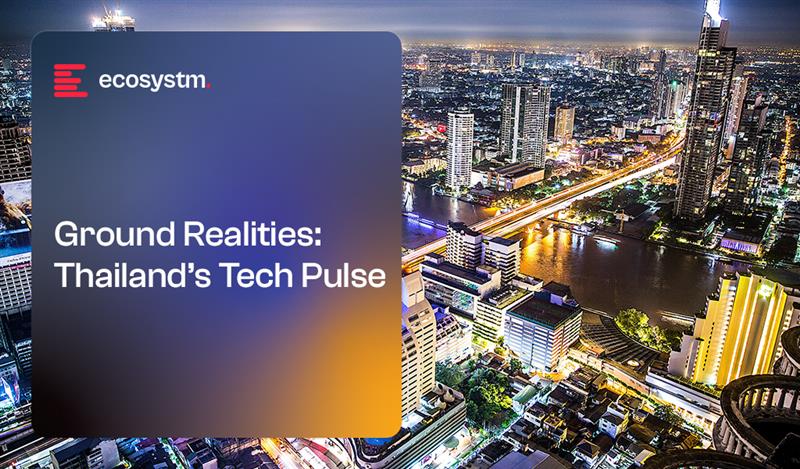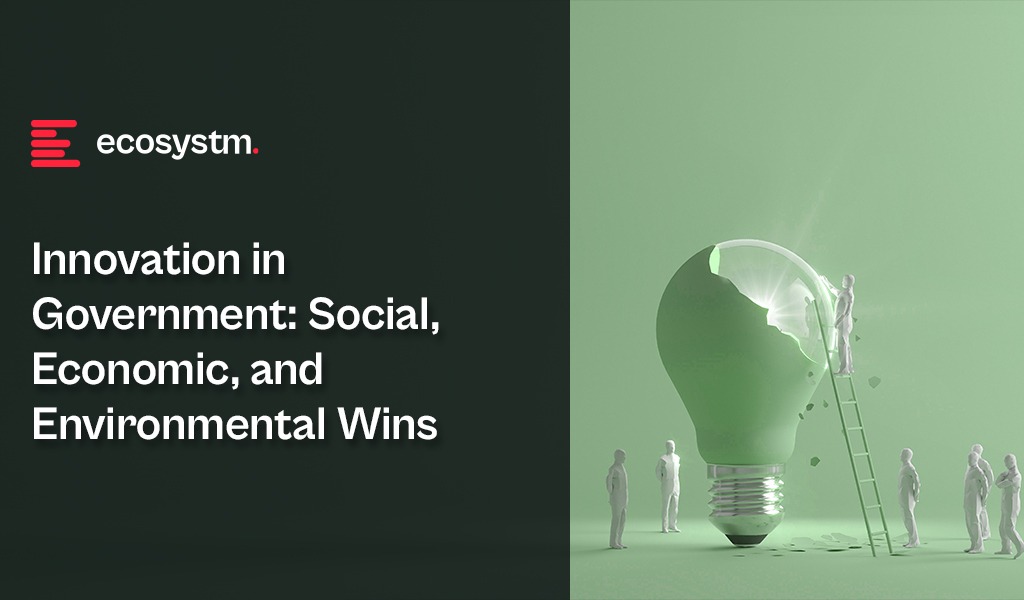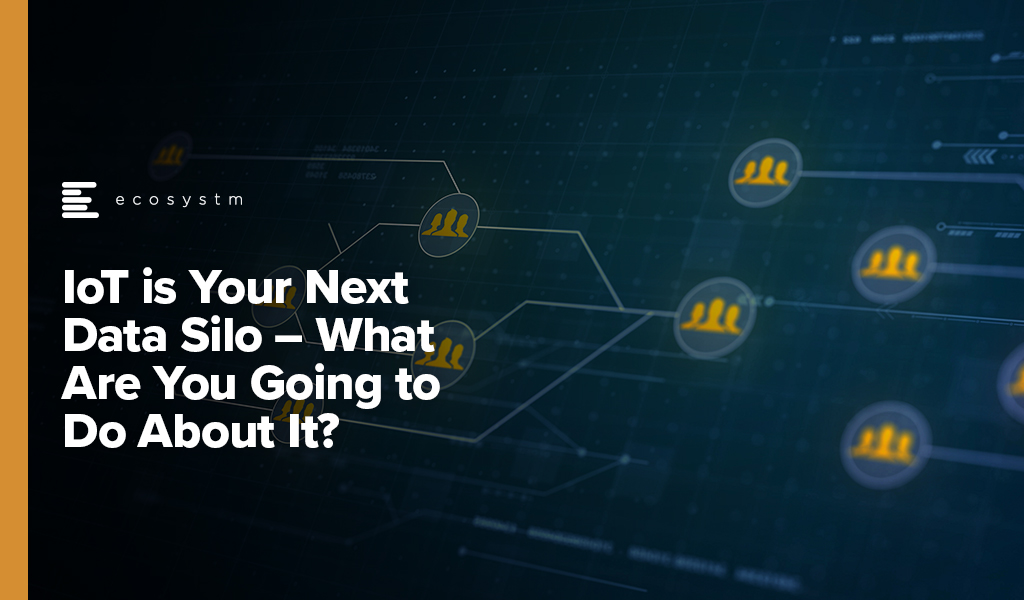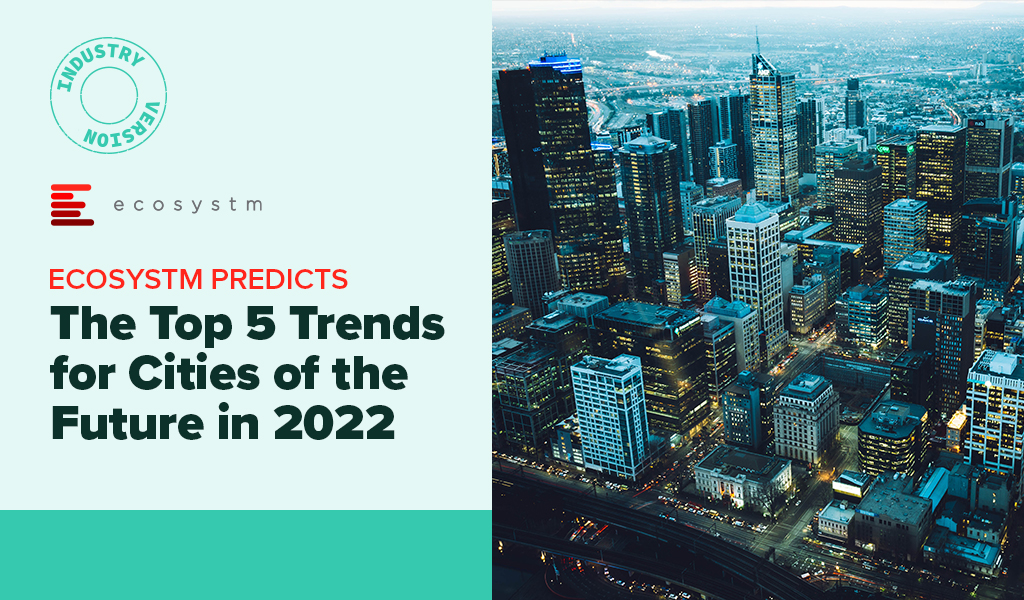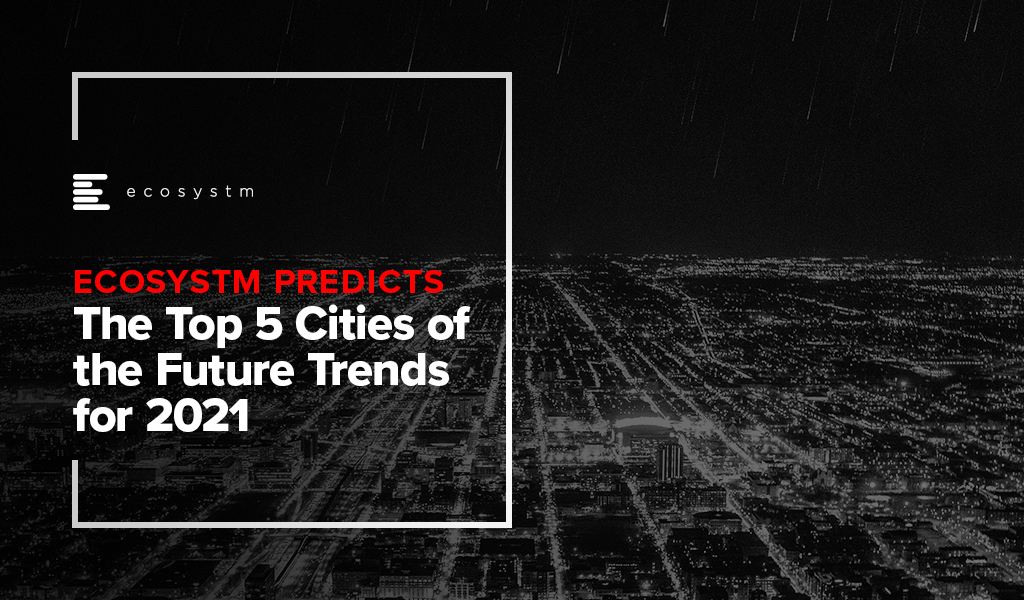Thailand’s digital transformation has shifted from an ambitious policy agenda to a national necessity. As the country accelerates its Thailand 4.0 strategy, digital platforms are becoming central to boosting competitiveness, enhancing public services, and building economic resilience. From logistics and healthcare to finance and manufacturing, digital tools now underpin how Thailand moves, heals, pays, and grows.
Recent reforms, including the National AI Strategy, Smart City Masterplan, and National Digital ID framework, have been paired with efforts to strengthen digital infrastructure nationwide. Yet challenges remain: integrating platforms across government, closing the generational digital divide, and safeguarding vulnerable users in a rapidly evolving fintech and gig economy.
Through multiple roundtables and stakeholder dialogues, Ecosystm has uncovered five core themes that highlight both the momentum and the friction points in Thailand’s digital journey.
Theme 1: Bridging the Regional Divide
Thailand’s digital transformation is accelerating in urban centres like Bangkok, Chonburi, and Rayong, but rural and low-income regions, especially in the North and Deep South, continue to lag. Gaps in connectivity, digital skills, and modern technical education are limiting access to online learning, mobile banking, and digital public services, while also holding back the growth of tech-driven industries.
Initiatives like Net Pracharat have brought broadband to over 75,000 villages, and new investments in regional data centres and telecom infrastructure show promise. Still, last-mile gaps and fragile networks persist, particularly in conflict-affected or underserved areas. Even where fibre is available, unstable connections often block meaningful digital adoption.
At the same time, Thailand’s push into future-focused industries such as EVs, semiconductors, AI, and smart logistics, is straining its talent pipeline. The Eastern Economic Corridor (EEC) is attracting major investment, but the demand for skilled workers in data science, cybersecurity, and industrial AI far exceeds supply. Many regional technical education systems have not kept pace, widening the skills gap.
To ensure inclusive growth, Thailand needs to pair infrastructure investment with targeted reskilling and education reform. Programs like the Digital Skill Development Academy and revamped TVET initiatives are important first steps; but broader progress will require stronger industry-academia partnerships, faster certification pathways, and universal access to digital learning.
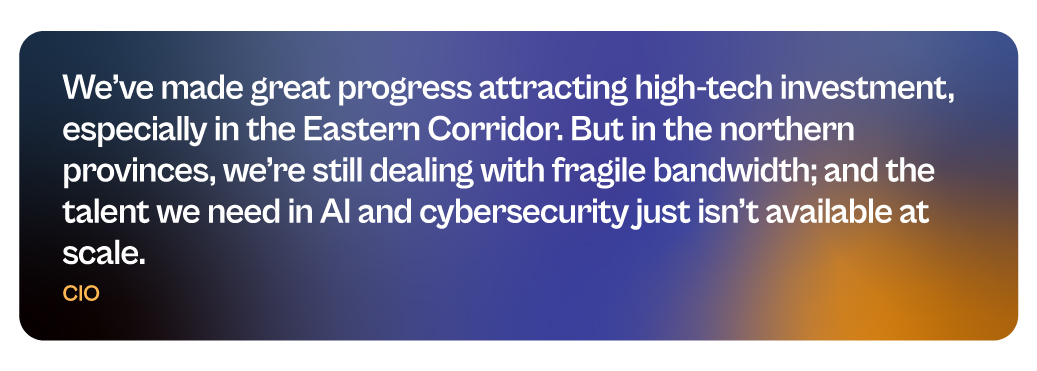
Theme 2: Unifying Government Services for a Seamless Citizen Journey
From PromptPay-linked welfare payments and Mor Prom for health services, to the rollout of the NDID (National Digital ID), Thailand has made considerable progress in digitalising public services. Citizens can now access more services online than ever before.
However, many of these systems still operate in silos, with duplicated citizen data, separate logins, and limited backend integration between agencies. Ministries and local governments often lack the interoperability standards and cloud infrastructure needed to provide seamless, real-time services.
The next phase of government digitalisation must focus on platform-level integration, supported by secure data sharing frameworks, API-first design, and privacy-by-default policies. The goal is to move from digitising transactions to building a citizen-centric, connected state, where services are proactive, mobile-friendly, and unified across domains.

Theme 3: Strengthening Public Trust Through Proactive Cybersecurity
With the rise of digital government, cloud adoption, and cashless ecosystems, Thailand’s attack surface is rapidly expanding. High-profile breaches in healthcare, telecom, and finance have triggered growing public concern around data misuse, fraud, and infrastructure vulnerabilities.
The government has enacted the Cybersecurity Act (2019) and PDPA (2022), and agencies like the National Cybersecurity Agency (NCSA) are stepping up threat monitoring. But cybersecurity maturity across sectors remains uneven. Many SMEs, regional hospitals, and even provincial government systems operate with limited threat intelligence and minimal incident response protocols.
Cybersecurity must now move from compliance to strategic resilience. This includes building sector-specific response plans, launching cyber drills in critical infrastructure, and scaling cyber talent development across the country. Trust in digital services will depend not just on what’s offered, but on how securely it’s delivered.

Theme 4: Scaling Trust Through Local Language, Visibility, and Human Oversight
AI systems in Thailand are increasingly interfacing with the public, from chatbots and digital assistants to automated approvals and diagnostics. However, public trust in these systems remains fragile, particularly when users cannot understand how decisions are made or get help when things go wrong.. Language barriers and unclear design only add to the uncertainty.
Many AI tools are built in English-first environments, with limited Thai-language optimisation or cultural context. In rural areas or among older populations, this can create friction and resistance, even when the underlying system works well. Without transparency, user control, or recourse, AI tools risk being seen as alienating rather than empowering.
To build public confidence, AI deployments must prioritise explainability, Thai-language usability, and built-in pathways for human support. This includes interface localisation, clear model intent statements, and fallback mechanisms. Trust will not be built through performance alone, it must be earned through transparency, accessibility, and responsiveness.

Theme 5: Embedding Governance to Sustain Smart Urban Growth
Thailand has made significant headway in its smart city development agenda, with over 30 provinces participating in the national Smart City program. Flagship initiatives in Phuket, Chiang Mai, Khon Kaen, and parts of the EEC have introduced smart traffic systems, e-governance tools, environmental monitoring, and digital tourism platforms.
However, many smart city projects are still pilots, driven by local champions, reliant on short-term grants, and lacking long-term governance structures. Fragmented data, unclear stakeholder roles, and limited collaboration between cities continue to slow scale and national replication.
The Smart City Office under DEPA is working to address these challenges by developing standard frameworks, urban data platforms, and public-private investment models. To maintain momentum, Thailand will need to embed smart city governance in multi-year digital urban strategies, establish shared infrastructure foundations, and invest in capacity-building for local leaders.
For smart cities to succeed, they must move beyond tech demonstrations and deliver real, lasting improvements in liveability, safety, and economic opportunity.

Sustaining Momentum in a Connected Nation
Thailand’s digital future won’t be defined by policy or technology alone; but by how effectively the country aligns infrastructure, skills, services, and trust at scale. The foundations are already being built in classrooms, city halls, data centres, and boardrooms. The real opportunity lies in weaving these efforts into a cohesive, resilient digital fabric. Lasting impact will come not just from momentum, but from turning vision into everyday value for people, communities, and businesses alike.

Governments worldwide struggle with intricate social, economic, and environmental challenges. Tight budgets often leave them with limited resources to address these issues head-on. However, innovation offers a powerful path forward.
By embracing new technologies, adapting to cultural shifts, and fostering new skills, structures, and communication methods, governments can find solutions within existing constraints.
Find out how public sector innovation is optimising internal operations, improving service accessibility, bridging the financial gap, transforming healthcare, and building a sustainable future.
Click here to download ‘Innovation in Government: Social, Economic, and Environmental Wins’ as a PDF
Optimising Operations: Tech-Driven Efficiency
Technology is transforming how governments operate, boosting efficiency and allowing employees to focus on core functions.
Here are some real-world examples.
Singapore Streamlines Public Buses. A cloud-based fleet management system by the Land Transport Authority (LTA) improves efficiency, real-time tracking, data analysis, and the transition to electric buses.
Dubai Optimises Utilities Through AI. The Dubai Electricity and Water Authority (DEWA) leverages AI for predictive maintenance, demand forecasting, and grid management. This enhances service reliability, operational efficiency, and resource allocation for power and water utilities.
Automation Boosts Hospital Efficiency. Singapore hospitals are using automation to save man-hours and boost efficiency. Tan Tock Seng Hospital automates bacteria sample processing, increasing productivity without extra staff, while Singapore General Hospital tracks surgical instruments digitally, saving thousands of man-hours.
Tech for Citizens
Digital tools and emerging technologies hold immense potential to improve service accessibility and delivery for citizens. Here’s how governments are leveraging tech to benefit their communities.
Faster Cross-Border Travel. Malaysia’s pilot QR code clearance system expedites travel for factory workers commuting to Singapore, reducing congestion at checkpoints.
Metaverse City Planning. South Korea’s “Metaverse 120 Center” allows residents to interact with virtual officials and access services in a digital environment, fostering innovative urban planning and infrastructure management.
Streamlined Benefits. UK’s HM Revenue and Customs (HMRC) launched an online child benefit claim system that reduces processing time from weeks to days, showcasing the efficiency gains possible through digital government services.
Bridging the Financial Gap
Nearly 1.7 billion adults or one-third globally, remain unbanked.
However, innovative programs are bridging this gap and promoting financial inclusion.
Thailand’s Digital Wallet. Aimed at stimulating the economy and empowering underserved citizens, Thailand disburses USD 275 via digital wallets to 50 million low-income adults, fostering financial participation.
Ghana’s Digital Success Story. The first African nation to achieve 100% financial inclusion through modernised platforms like Ghana.gov and GhanaPay, which facilitate payments and fee collection through various digital channels.
Philippines Embraces QR Payments. The City of Alaminos leverages the Paleng-QR Ph Plus program to promote QR code-based payments, aligning with the central bank’s goal of onboarding 70% of Filipinos into the formal financial system by 2024.
Building a Sustainable Future
Governments around the world are increasingly turning to technology to address environmental challenges and preserve natural capital.
Here are some inspiring examples.
World’s Largest Carbon Capture Plant. Singapore and UCLA joined forces to build Equatic-1, a groundbreaking facility that removes CO2 from the ocean and creates carbon-negative hydrogen.
Tech-Enhanced Disaster Preparedness. The UK’s Lincolnshire County Council uses cutting-edge geospatial technology like drones and digital twins. This empowers the Lincolnshire Resilience Forum with real-time data and insights to effectively manage risks like floods and power outages across their vast region.
Smart Cities for Sustainability. Bologna, Italy leverages the digital twins of its city to optimise urban mobility and combat climate change. By analysing sensor data and incorporating social factors, the city is strategically developing infrastructure for cyclists and trams.
Tech for a Healthier Tomorrow
Technology is transforming healthcare delivery, promoting improved health and fitness monitoring.
Here’s a glimpse into how innovation is impacting patient care worldwide.
Robotic Companions for Seniors. South Korea tackles elder care challenges with robots. Companion robots and safety devices provide companionship and support for seniors living alone.
VR Therapy for Mental Wellness. The UAE’s Emirates Health Services Corporation implements a Virtual Reality Lab for Mental Health, that creates interactive therapy sessions for individuals with various psychological challenges. VR allows for personalised treatment plans based on data collected during sessions.

With over 70% of the world’s population predicted to live in cities by 2050, smart cities that use data, technology, and AI to streamline services are key to ensuring a healthy and safe environment for all who live, work, or visit them.
Fueled by rapid urbanisation, Southeast Asia is experiencing a smart city boom with an estimated 100 million people expected to move from rural areas to cities by 2030.
Despite their diverse populations and varying economic stages, ASEAN member countries are increasingly on the same page: they are all united by the belief that smart cities offer a solution to the complex urban and socio-economic challenges they face.
Read on to discover how Southeast Asian countries are using new tools to manage growth and deliver a better quality of life to hundreds of millions of people.
ASCN: A Network for Smarter Cities
The ASEAN Smart Cities Network (ASCN) is a collaborative platform where cities in the region exchange insights on adopting smart technology, finding solutions, and involving industry and global partners. They work towards the shared objective of fostering sustainable urban development and enhancing livability in their cities.
As of 2024, the ASCN includes 30 members, with new additions from Thailand and Indonesia.
“The ASEAN Smart Cities Network provides the sort of open platform needed to drive the smart city agenda. Different cities are at different levels of developments and “smartness” and ASEAN’s diversity is well suited for such a network that allows for cities to learn from one another.”
Taimur Khilji
UNITED NATIONS DEVELOPMENT PROGRAMME (UNDP)
Singapore’s Tech-Driven Future
The Smart Nation Initiative harnesses technology and data to improve citizens’ lives, boost economic competitiveness, and tackle urban challenges.
Smart mobility solutions, including sensor networks, real-time traffic management, and integrated public transportation with smart cards and mobile apps, have reduced congestion and travel times.
Ranked 5th globally and Asia’s smartest city, Singapore is developing a national digital twin to for better urban management. The 3D maps and subsurface model, created by the Singapore Land Authority, will help in managing infrastructure and assets.
The Smart City Initiative promotes sustainability with innovative systems like automated pneumatic waste collection and investments in water management and energy-efficient solutions.
Malaysia’s Holistic Smart City Approach
With aspirations to become a Smart Nation by 2040 (outlined in their Fourth National Physical Plan – NPP4), Malaysia is making strides.
Five pilot cities, including Kuala Lumpur and Johor Bahru, are testing the waters by integrating advanced technologies to modernise infrastructure.
Pilots embrace sustainability, with projects like Gamuda Cove showcasing smart technologies for intelligent traffic management and centralised security within eco-friendly developments.
Malaysia’s Smart Cities go beyond infrastructure, adopting international standards like the WELL Building Standard to enhance resident health, well-being, and productivity. The Ministry of Housing and Local Government, collaborating with PLANMalaysia and the Department of Standards Malaysia, has established clear indicators for Smart City development.
Indonesia’s Green Smart City Ambitions
Eyeing carbon neutrality by 2060, Indonesia is pushing its Smart City initiatives.
Their National Long-Term Development Plan prioritises economic growth and improved quality of life through digital infrastructure and innovative public services.
The goal is 100 smart cities that integrate green technology and sustainable infrastructure, reflecting their climate commitment.
Leaving behind congested Jakarta, Indonesia is building Nusantara, the world’s first “smart forest city“. Spanning 250,000 hectares, Nusantara will boast high-capacity infrastructure, high-speed internet, and cutting-edge technology to support the archipelago’s activities.
Thailand’s Smart City Boom
Thailand’s national agenda goes big on smart cities.
They aim for 105 smart cities by 2027, with a focus on transportation, environment, and safety.
Key projects include:
- USD 37 billion smart city in Huai Yai with business centres and housing for 350,000.
- A 5G-powered smart city in Ban Chang for enhanced environmental and traffic management.
- USD $40 billion investment to create a smart regional financial centre across Chonburi, Rayong, and Chachoengsao.
Philippines Fights Urban Challenges with Smart Solutions
By 2050, population in cities is expected to soar to nearly 102 million – twice the current figure.
A glimmer of optimism emerges with the rise of smart city solutions championed by local governments (LGUs).
Rapid urbanisation burdens the Philippines with escalating waste. By 2025, daily waste production could reach a staggering 28,000 tonnes. Smart waste management solutions are being implemented to optimise collection and reduce fuel consumption.
Smart city developer Iveda is injecting innovation. Their ambitious USD 5 million project brings AI-powered technology to cities like Cebu, Bacolod, Iloilo, and Davao. The focus: leverage technology to modernise airports, roads, and sidewalks, paving the way for a more sustainable and efficient urban future.

The Internet of Things (IoT) solutions require data integration capabilities to help business leaders solve real problems. Ecosystm research finds that the problem is that more than half of all organisations are finding integration a key challenge – right behind security (Figure 1). So, chances are, you are facing similar challenges.
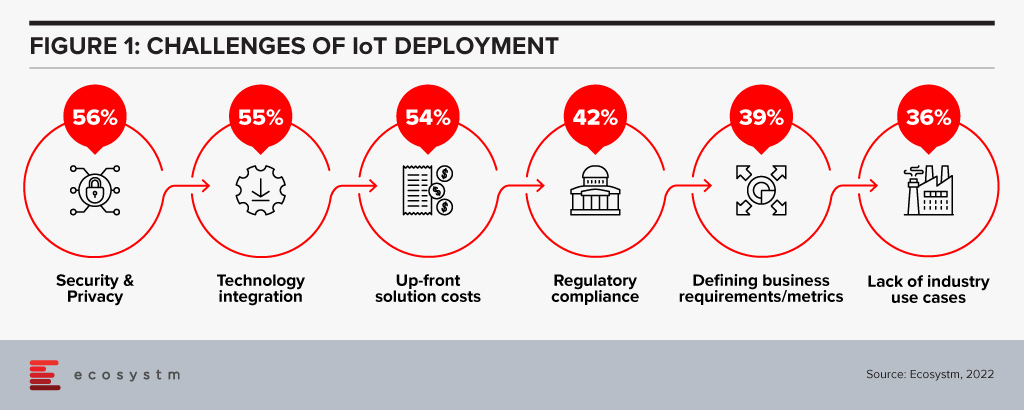
This should not be taken as a criticism of IoT; just a wake-up call for all those seeking to implement what has long been test-lab technology into an enterprise environment. I love absolutely everything about IoT. IT is an essential technology. Contemporary sensor technologies are at the core of everything. It’s just that there are a lot of organisations not doing it right.
Like many technologists, I was hooked on IoT since I first sat in a Las Vegas AWS re: invent conference breakout session in 2015 and learned about MQTT protocols applied to any little thing, and how I could re-order laundry detergent or beer with an AWS button, that clumsy precursor to Alexa.
Parts of that presentation have stayed with me to this day. Predict and act. What business doesn’t want to be able to do that better? I can still see the room. I still have those notes. And I’m still working to help others embrace the full potential of this must-have enterprise capability.
There is no doubt that IoT is the Cinderella of smart cities. Even digital twinning. Without it, there is no story. It is critical to contemporary organisations because of the real-time decision-making data it can provide into significant (Industry 4.0) infrastructure and service investments. That’s worth repeating. It is critical to supporting large scale capital investments and anyone who has been in IT for any length of time knows that vindicating the need for new IT investments to capital holders is the most elusive of business demands.
But it is also a bottom-up technology that requires a top-down business case – a challenge also faced by around 40% of organisations in the Ecosystm study – and a number of other architectural components to realise its full cost-benefit or capital growth potential. Let’s not quibble, IoT is fundamental to both operational and strategic data insights, but it is not the full story.
If IoT is the belle of the smart cities ball, then integration is the glass slipper that ties the whole story together. After four years as head of technology for a capital city deeply committed to the Smart City vision, if there was one area of IoT investment I was constantly wishing I had more of, it was integration. We were drowning in data but starved of the skills and technology to deliver true strategic insights outside of single-function domains.

This reality in no way diminishes the value of IoT. Nor is it either a binary or chicken-and-egg question of whether to invest in IoT or integration. In fact, the symbiotic market potential for both IoT and integration solutions in asset-intensive businesses is not only huge but necessary.
IoT solutions are fundamental contemporary technologies that provide the opportunity for many businesses to do well in areas they would otherwise continue to do very poorly. They provide a foundation for digital enablement and a critical gateway to analytics for real-time and predictive decision making.
When applied strategically and at scale, IoT provides a magical technology capability. But the bottom line is that even magic technology can never carry the day when left to do the work of other solutions. If you have already plunged into IoT then chances are it has already become your next data silo. The question is now, what you are going to do about it?
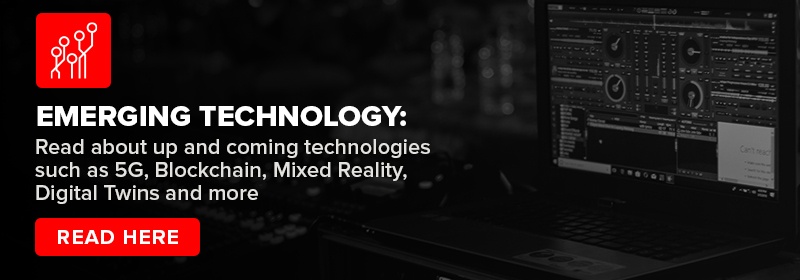
Cities worldwide have been facing unexpected challenges since 2020 – and 2022 will see them continue to struggle with the after-effects of COVID-19. However, there is one thing that governments have learnt during this ongoing crisis – technology is not the only aspect of a Cities of the Future initiative. Besides technology, Cities of the Future will start revisiting organisational and institutional structures, prioritise goals, and design and deploy an architecture with data as its foundation.
Cities of the Future will focus on being:
- Safe. Driven by the ongoing healthcare crisis
- Secure. Driven by the multiple cyber attacks on critical infrastructure
- Sustainable. Driven by citizen consciousness and global efforts such as the COP26
- Smart. Driven by the need to be agile to face future uncertainties
Read on to find out what Ecosystm Advisors, Peter Carr, Randeep Sudan, Sash Mukherjee and Tim Sheedy think will be the leading Cities of the Future trends for 2022.
Click here to download Ecosystm Predicts: The Top 5 Trends for Cities of the Future in 2022

Blockchain and Distributed Ledger Technology (DLT) is set to transform various aspects of the Financial Services industry. The technologies have a role to play in automating processes such as payments and securitisation, claims, and compliance monitoring.
Where the industry will see real value is in governance and standards around data sharing and collaboration – which lies at the core of the Open Banking revolution.
This Ecosystm Snapshot looks at how Blockchain in Financial Services is fast becoming a reality – and how different stakeholders (such as ABF, IMDA, Singapore Customs, Visa, Mastercard, TCS, Bitpanda and others) are looking to leverage it.

In this Ecosystm Insight, our guest author Randeep Sudan shares his views on how Cities of the Future can leverage technology for future resilience and sustainability. “Technology is not the only aspect of Smart City initiatives. Besides technology, we need to revisit organisational and institutional structures, prioritise goals, and design and deploy an architecture with data as its foundation.”

Earlier this year, Sudan participated in a panel discussion organised by Microsoft where he shared his views on building resilient and sustainable Cities of the Future. Here are his key messages for policymakers and funding agencies that he shared in that session.
“Think ahead, Think across, and Think again! Strategic futures and predictive analytics is essential for cities and is critical for thinking ahead. It is also important to think across through data unification and creating data platforms. And the whole paradigm of innovation is thinking again.”

Public sector organisations are looking at 2021 as the year where they either hobble back to normalcy or implement their successful pilots (that were honed under tremendous pressure). Ecosystm research finds that 60% of government agencies are looking at 2021 as the year they make a recovery to normal – or the normal that finally emerges. The path to recovery will be technology-driven, and this time they will look at scalability and data-driven intelligence.
Ecosystm Advisors Alan Hesketh, Mike Zamora and Sash Mukherjee present the top 5 Ecosystm predictions for Cities of the Future in 2021. This is a summary of our Cities of the Future predictions – the full report (including the implications) is available to download for free on the Ecosystm platform here.
The Top 5 Cities of the Future Trends for 2021
#1 Cities Will Re-start Their Transformation Journey by Taking Stock
In 2021 the first thing that cities will do is introspect and reassess. There have been a lot of abrupt policy shifts, people changes, and technology deployments. Most have been ad-hoc, without the benefit of strategy planning, but many of the services that cities provide have been transformed completely. Government agencies in cities have seen rapid tech adoption, changes in their business processes and in the mindset of how their employees – many who were at the frontline of the crisis – provide citizen services.
Technology investments, in most cases, took on an unexpected trajectory and agencies will find that they have digressed from their technology and transformation roadmap. This also provides an opportunity, as many solutions would have gone through an initial ‘proof-of-concept’ without the formal rigours and protocols. Many of these will be adopted for longer term applications. In 2021, they will retain the same technology priorities as 2020, but consolidate and strengthen on their spend.
#2 Cities Will be Instrumented Using Intelligent Edge Devices
The capabilities of edge devices continue to increase dramatically, while costs decline. This reduces the barriers to entry for cities to collect and analyse significantly more data about the city and its people. Edge devices move computational power and data storage as close to the point of usage as possible to provide good performance. Devices range from battery powered IoT devices for data collection through to devices such as smart CCTV cameras with embedded pattern recognition software.
Cities will develop many use cases for intelligent edge devices. These uses will range from enhancing old assets using newer approaches to data collection – through to accelerating the speed and quality of the build of a new asset. The move to data-driven maintenance and decision-making will improve outcomes.
#3 COVID-19 Will Impact City Design
The world has received a powerful reminder of the vulnerability of densely populated cities, and the importance of planning and regulating public health. COVID-19 will continue to have an impact on city design in 2021.
A critical activity in controlling the pandemic in this environment is the test-and-trace capabilities of the local public health authorities. Technology to provide automated, accurate, contact tracing to replace manual efforts is now available. Scanning of QR codes at locations visited is proving to be the most widely adopted approach. The willingness of citizens to track their travels will be a crucial aid in managing the spread of COVID-19.
Early detection of new disease outbreaks, or other high-risk environmental events, is essential to minimise harm. Intelligent edge devices that detect the presence of viruses will become crucial tools in a city’s defence.
Intelligent edge devices will also play a role in managing building ventilation. Well-ventilated spaces are an important factor in controlling virus transmission. But a limited number of buildings have ventilation systems that are capable of meeting those requirements. Property owners will begin to refit their facilities to provide better air movement.
#4 Technology Vendors Will Emerge as the Conductors of Cities of the Future
The built environment comprises not only of the physical building, but also the space around the buildings and building operations. The real estate developer/investor owns the building – the urban fabric, the relationship of buildings to each other, the common space and the common services provided to the city, is owned by the City. The question is who will coordinate the players, e.g. business, citizens, government and the built environment. Ideally the government should be the conductor. However, they may not have sufficient experience or knowledge to properly implement this role. This means a capable and knowledgeable neutral consultant will at least initially fill this role. There is an opportunity for a technology vendor to fill that consulting role and impact the city fabric. This enhanced city environment will be requested by the Citizen, driven by the City, and guided by Technology Vendors. 2021 will see leading technology vendors working very closely with cities.
#5 Compliance Will be at the Core of Citizen Engagement Initiatives
Many Smart Cities have long focused on online services – over the last couple of years mobile apps have further improved citizen services. In 2020, the pandemic challenged government agencies to continue to provide services to citizens who were housebound and had become more digital savvy almost overnight. And many cities were able to scale up to fulfill citizen expectations.
However, in 2021 there will be a need to re-evaluate measures that were implemented this year – and one area that will be top priority for public sector agencies is compliance, security and privacy.
The key drivers for this renewed focus on security and privacy are:
- The need to temper the focus of ‘service delivery at any cost’ and further remind agencies and employees that security and privacy must comply with standard to allow the use of government data.
- The rise of cyberattacks that target not only essential infrastructure, but also individual citizens and small and medium enterprises (SMEs).
- The rise of app adoption by city agencies – many that have been developed by third parties. It will become essential to evaluate their compliance to security and privacy requirements.

Today nearly 56% of the global population lives in an urban environment. The city has finally become the dominant place to live. Given the changing environment and increasing technology, the city has begun to dramatically change in the past 5-10 years. And it will continue to evolve and change at an increasingly faster pace.
As technology has developed and influenced the city, the term “Smart City” has become prevalent. Technology is an important attribute of a city’s evolution. However, it is just one of the attributes. A more encompassing and enduring term could be a “Sustainable City”. The definition of a Sustainable City that I subscribe to is:
“A vibrant community which can adapt and grow over the years, due to changing demographics and economic conditions. It is based upon multiple attributes.”
This definition begins to describe the holistic and long-term issues associated with the complexities of an urban environment. A Sustainable City has a goal of being an enduring and competitive place to work, live, learn, and play. It requires many aspects. Some of these are:
- Purpose. Entertain, eat, work, live, learn
- Activities. Walk, bike, play, work, learn, etc.
- Scale. Human scale not mega blocks
- Natural Environment. Location, terrain, water, etc.
- Environmental Implications. Resource usage, output disposal, environmental footprint, etc.
- Dynamic. Changing through the day/week as needed (festival, farmer’s markets, sporting event)
- Transportation. Walk, bike, mass transit – beyond cars
- Connectivity. Smart & effective infrastructure (utility & transportation coordination, etc.)
- Built Environment. Smart & efficiently operated buildings, spaces, etc.
A city is also a three-dimensional physical puzzle. It is composed of multiple layers: Subterranean level (utilities, transportation, walkways, retail); Ground level (streets, walkways, public spaces, open areas, building entrances); Concourse (walkways, retail, elevated rail, etc.); and Air Space (skyscrapers, bridges). This three-dimensional layout adds a level of complexity.
Key Stakeholders in a Sustainable City
Another important layer to consider consists of the four main players that need to work together:
- People (employees, students, families, tourists)
- Businesses (large, small/medium, start-ups, etc.)
- Built Environment (developers, real estate investors, consultants, designers, engineers, etc.)
- Government (local and regional)
For a city to be enduring and sustainable, the four main players need to work in a concerted effort. They need to discuss, advise, decide and provide for an environment which can change or be modified based upon a particular city’s needs. No one player truly has the ability to control how the city develops over time. Instead all of them work together along with the marketplace and land economics to determine the success of a city in the long run. Idea generation can come from any of these players and is tested in the marketplace. Figure 1 shows the interactions between these four key stakeholders. When all the groups work together, they are able to attain that “Sweet Spot” which enables a location to have the characteristics of a sustainable Global City. In the most simplistic terms, the Sweet Spot for a Sustainable City is the on-going quality of life that the city provides to its occupants.

The Dynamic Nature of a Sustainable City
Some believe that once a city or regional masterplan has been developed and approved the only thing left is to implement and enjoy. As a city and its inhabitants are dynamic, a longer-term sustainable view might be that the completion of the environment is just a starting point. The cases in point are the great global cities whose origins have started many generations ago, such as London, New York, Berlin, Tokyo, and so on This means that through use, the environment and space will constantly be assessed to evaluate if they are meeting the changing needs of the city or location. The appropriate adjustments or modifications are required over time. This is what has been done over the past centuries for many global cities. The difference between then and now is that with technology permeating everywhere, the ability to assess and adjust the environment will now be done at a much faster rate.
As builders and/or occupants of the environment we are just the current Stewards of the urban environment. Stewardship is a delicate balance between Return on Investment and Return to Society. The city is a dynamic environment which will continue to evolve over time based upon its changing needs. We have to determine whether we are going to change and improve the environment or just “pluck the fruits” from the existing assets. We should make sure that when we design and develop the urban environments it is with long-term sustainability in mind.



